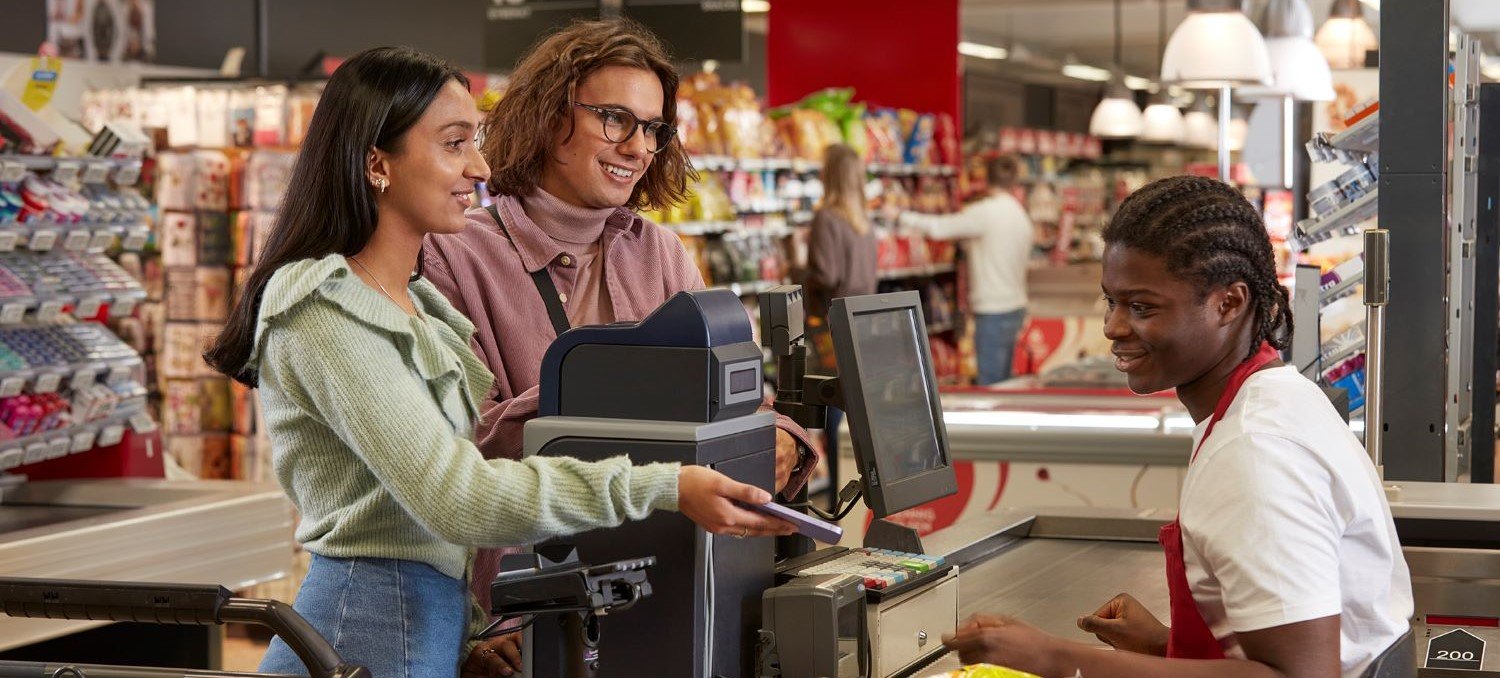Why high-volume recyclers can be high-value customers
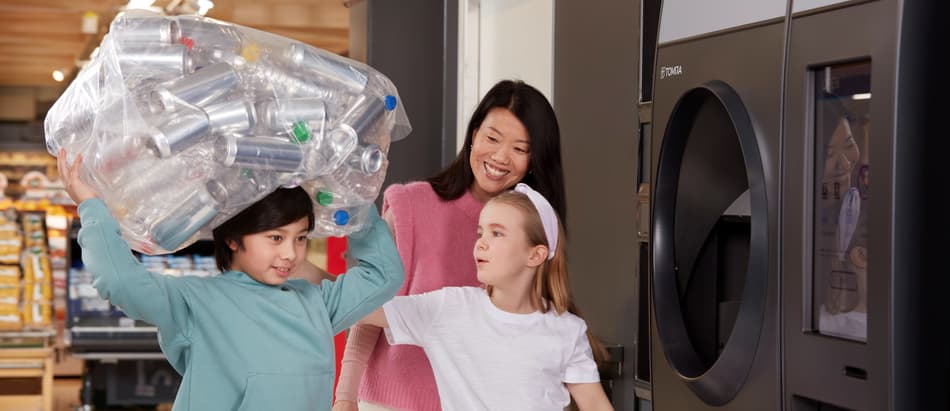
Understanding the habits and preferences of shoppers can have big implications, and offer significant opportunities for retailers.
Global reverse vending leader TOMRA Collection has surveyed consumers across seven European countries, producing data on what impacts their recycling choices and how retailers can respond. The resulting report, “How recycling habits impact shopping behavior: Consumer engagement with deposit return systems in Europe”, also shows how high-volume recyclers – those recycling more than 50 drink containers at a time – could be a group that retailers should pay particular attention to as highly engaged and highly valuable customers.
Deposit return systems (DRSs) – where consumers pay a small deposit on top of the price of a drink, which is refunded to the consumer when they return the empty bottle or can for recycling – have become well established across many countries in response to growing plastic pollution and demand for high-quality recycled materials.
Their popularity has strongly influenced consumer behavior, shaping how shoppers interact with grocery retailers, which are often return points for bottle and can recycling in a “return-to-retail” DRS. By examining these DRS-driven consumer habits, and particularly the habits of valuable high-volume recyclers, retailers may be able to capitalize on them and set their stores up for success.
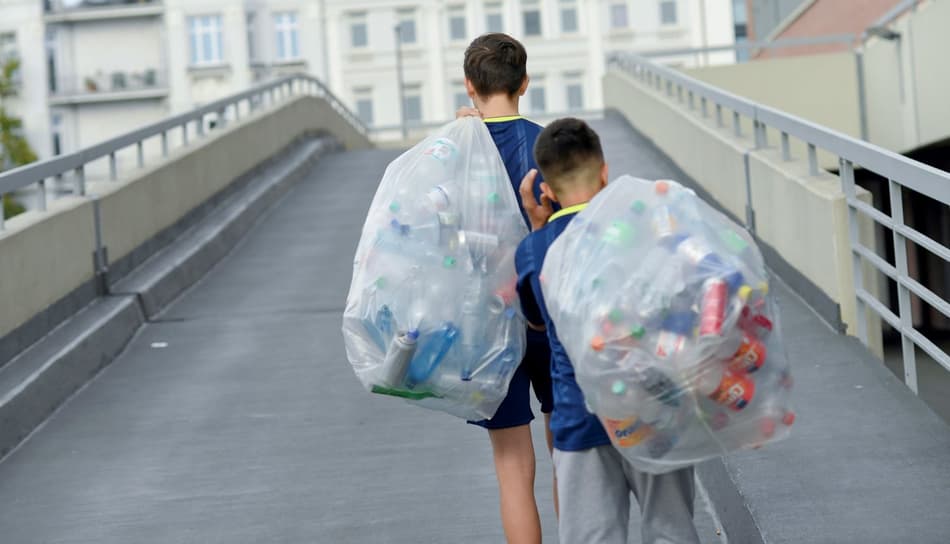
“Our research sought to understand what consumers want from an in-store recycling experience, and how retailers can capitalize on these insights,” explains Mette Mari Heyerdahl, Head of Marketing at TOMRA Collection.
“The survey findings demonstrate that recycling customers are valuable customers, who not only bring footfall to stores, but also revenue. Our report shows that when stores invest in their reverse vending facilities, they tap into a vital opportunity.”
High-volume recyclers – high-value customers
The TOMRA Collection study was conducted via online survey panels in Sweden, Norway, Finland, Denmark, Germany, the Netherlands and Slovakia in November 2022. Each market surveyed 1000 consumers, aged 18-70 and returning drink containers for recycling at least every second month.
High-volume recyclers made up 15% of the total survey sample, and members of this group are more likely to be a part of larger households and belong to younger age groups. They have greater access to a car than the general survey population and spend more on commodity goods, like groceries, per month.
Given the numbers of bottles and cans being recycled by this group per store visit (more than 50), they have the highest potential deposit refund. TOMRA’s research found that 83% of high-volume recyclers spend their deposit refund right there in the same store, meaning that most recycling trips are also shopping trips.
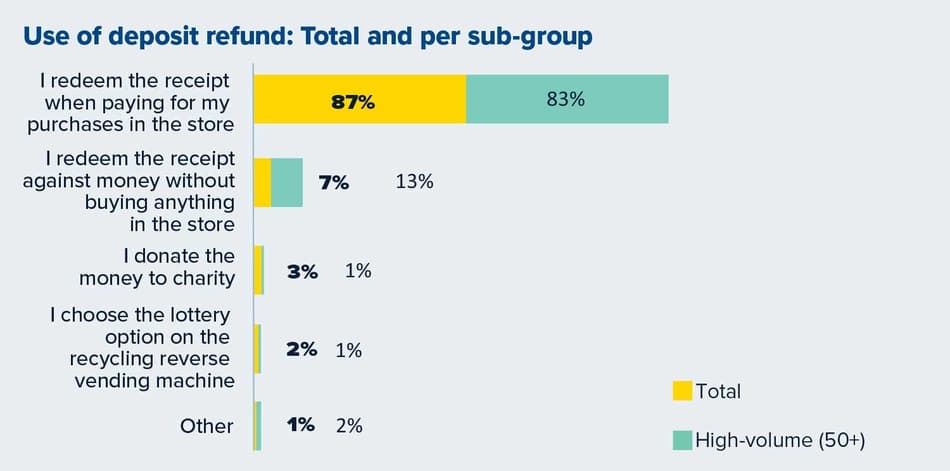
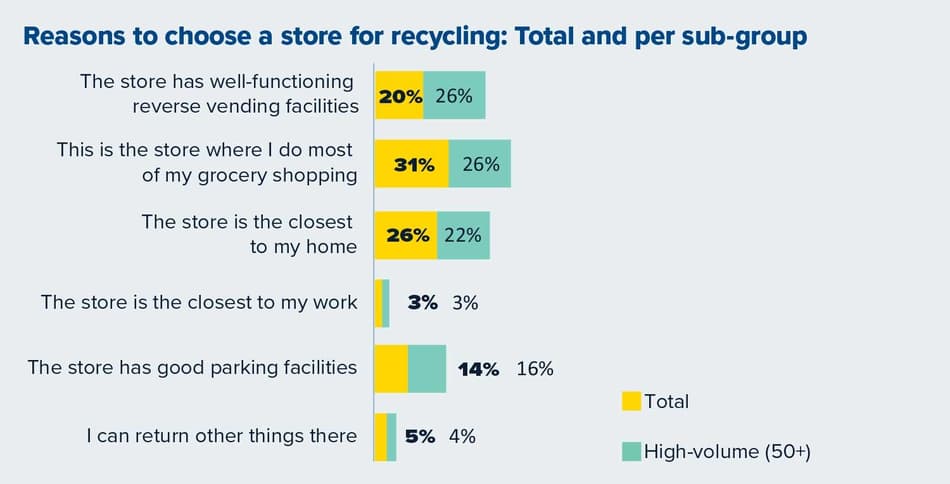
Our survey findings demonstrate that recycling customers in general are valuable customers, who not only bring footfall to stores, but spend money there. With high-volume recyclers, the opportunity is heightened. The report shows that by making their store a recycling destination and attracting these high-volume recyclers, retailers have the potential to increase their revenue.

So, what matters to this group? The survey revealed several factors at the top of high-volume recyclers’ wish lists:
- That the reverse vending machine (RVM) works well, without errors or stops (92%).
- RVMs that are easy to use (89%).
- Quick recognition and processing of containers (86%).
- The ability to return all container types to the same machine (83%).
- Staff that are easily contactable when difficulties arise (83%).
- Little to no queues (74%).
- Being able to recycle multiple containers in one go (67%, compared to the total study population at 48%).
- Having several RVMs available (59%, compared to the total study population at 48%).
Compared to the total study population, high-volume recyclers also put emphasis on having a trash bin close by the RVM and having somewhere to wash hands after recycling, showing that cleanliness of the reverse vending facilities also matters to this valuable group.
"Also interesting to note is what this group of recyclers does not want. Maximum uptime for RVMs was even more important for high-volume recyclers than the total survey population. More than a third (35%) of this group said they would go to another store if there was a queue or downtime at an RVM, emphasizing the importance of an efficient, quality recycling set up in stores,” says Mette Mari Heyerdahl.
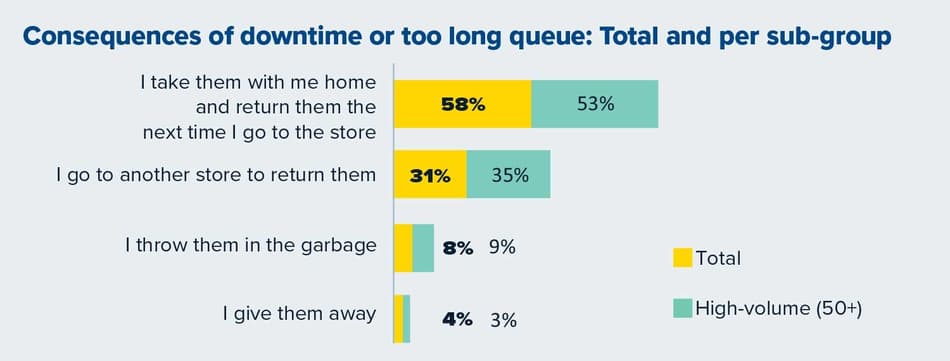
If retailers want to win and retain these valuable customers, they must ensure their recycling facilities are up to the task. The rewards could be very worthwhile.
Winning over high-volume recyclers
The study shows that high-volume recyclers are drawn to stores with quality RVM set-ups, and are primed and ready to spend their redeemed deposits in the store they recycle in. But, to capitalize on this, retailers must match customer expectations with in-store experience.
High-volume recyclers are particularly demanding – they want multiple RVMs, fast recycling and multi-feed options. Factoring in these elements could be key to winning these customers’ loyalty.
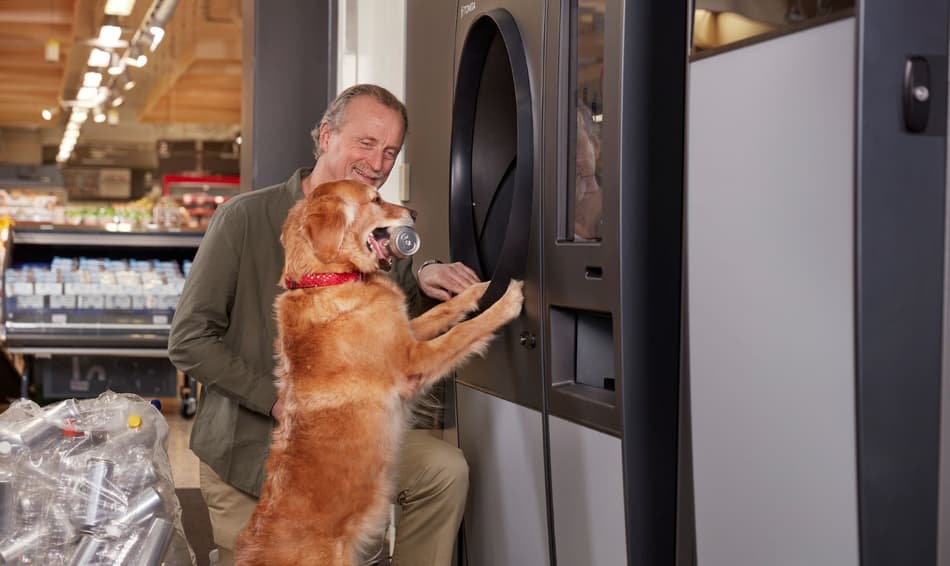
“Considering multi-feed options such as the TOMRA R1 reverse vending machine is one way to meet, and even exceed, high-volume recyclers’ expectations. Ensuring you have sufficient machines to meet demand, that they can accept all types of containers, are intuitive for customers to use, and that uptime is maximized, are big plus points, too,” continues Mette Mari Heyerdahl.
“But no matter which RVM set-up you opt for, ensuring the recycling area is clean, tidy and has as little wait time as possible gives customers a positive experience and makes repeat custom almost second nature.”
Optimizing in-store recycling facilities could reap benefits long into the future, too. The TOMRA survey showed that 66% of respondents would like to see the DRS concept expanded to other products; this figure was 73% for high-volume recyclers. This would present further opportunities for retailers.
High-volume recycling habits across Europe
While high-volume recyclers across the surveyed countries have broadly the same preferences and expectations when it comes to reverse vending facilities, there were several stand-out insights that retailers in particular countries may want to note:
- In Norway, Denmark and Sweden, high-volume recyclers made up a notably high percentage of the total surveyed population – 20%, 22% and 28% respectively.
- High-volume recyclers in Slovakia, Finland and Germany were particularly attuned to well-functioning RVM set-ups when choosing where to shop – 73%, 74% and 82% respectively said this was an important factor.
- More than 40% of high-volume recyclers in Norway and Slovakia, and 58% in Germany, said they would go to another store if an RVM had a queue or downtime.
- Having little to no queues is particularly important for those in Sweden, Denmark and Germany – 75%, 76% and 80% respectively said so.
- Speed is key for high-volume recyclers – more than 80% named this an important satisfaction point, 89% in Norway and Sweden, and 91% in Finland.
- Although high-volume recyclers in all countries showed a preference for multi-feed RVMs, this was particularly apparent in Germany (63%), Sweden (79%) and Norway (81%), where multi-feed RVMs are already available.
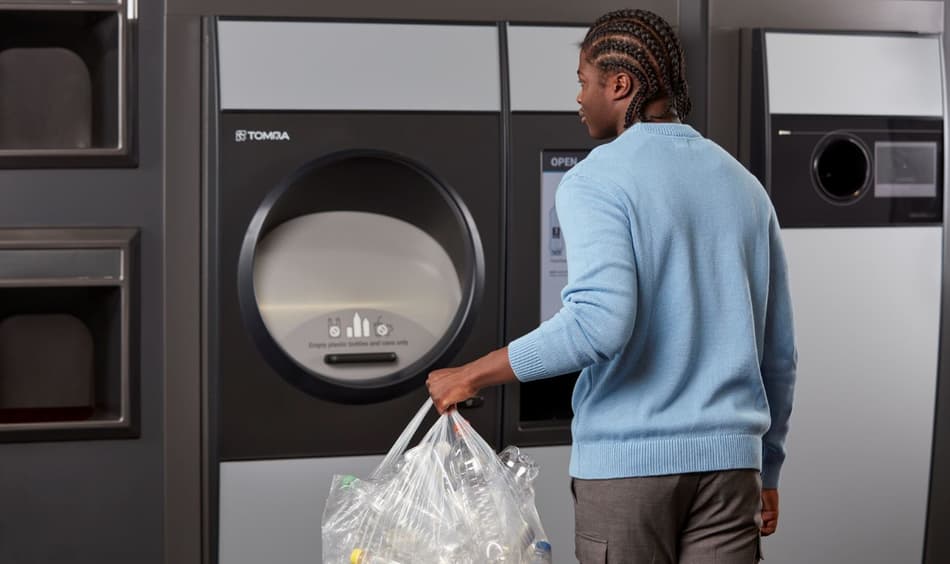
“These specific insights could allow retailers in particular countries to hone in on what most appeals to these high-value customers, and how large a percentage of their customers this group might represent,” comments Mette Mari Heyerdahl. “This could enable them to fine-tune their RVM offering even further, focusing on elements like speed, multi-feed systems and flow of customers, to maximize returns.”
A competitive edge that makes a difference
The report shines a light on the influence that deposit return has over shopper habits and the opportunities this offers retailers, especially with high-value, high-volume recyclers. By using its findings, retailers can have a better understanding of customer behavior, use that understanding to improve the recycling experience they provide, and in turn drive traffic, loyalty and revenue to their store.
By translating our report into in-store action, retailers can harness the power of reverse vending and gain a competitive advantage for their business, all while playing their part in reducing plastic pollution in their community and making a difference to the environment.

